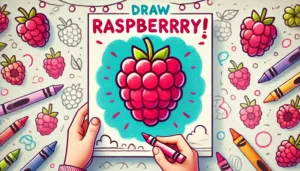A bulldozer is an exciting and useful vehicle for children to sketch. Its large components, such as blades and tracks, provide a great opportunity for kids to practice their drawing skills while learning about construction machinery.
Materials Needed
- Basic Supplies: Eraser, paper, and pencil for sketching.
- Coloring Tools: Crayons, colored pencils, or markers.
- Optional Items: Black marker for outlining and a ruler for straight edges.
Identifying the Shapes of a Bulldozer
A bulldozer consists mainly of squares, rectangles, and circles.
The body of the bulldozer is often a large rectangle, while the tracks are made up of long rectangles with repeating patterns of circles or lines.
Step-by-Step Guide to Drawing a Bulldozer
Step 1: Drawing the Tracks
Start with a long horizontal rectangle at the bottom to represent the tracks.
Inside the track, add a slightly smaller rectangle to add depth.
Step 2: Creating the Tracks’ Treads
Draw vertical lines across the larger rectangle to create segments that replicate the treads on the tracks.
Next, position smaller circles within the tracks to represent the rollers.
Step 3: Constructing the Body
Above the tracks, draw a large rectangle or square to represent the bulldozer’s body.
Draw a smaller rectangle to one side of the body to represent the operator’s cabin.
Step 4: Adding the Blade
At the front of the bulldozer, draw a wide rectangle for the blade.
Use diagonal lines to connect the blade to the body, representing the support arms.
Step 5: Adding Cabin Details
Draw a small rectangular window inside the cabin.
Include small details like a seat, steering controls, or levers that would be visible through the window.
Step 6: Final Details
Add extra features like exhaust pipes, headlights, and warning lights at the top of the body.
Don’t forget the small bolts and hinges on the blade for realism.
Step 7: Coloring the Bulldozer
Color the body of the bulldozer with bright yellow or orange.
The tracks should be black or grey, while the blade can be painted metallic.
Use light blue for the windows and add shading for depth.
Guidelines for Enriching Your Bulldozer Drawing
- Light Pencil Strokes: Begin with light pencil strokes to easily erase mistakes.
- Use a Ruler: For neat, straight edges, use a ruler to draw the body and tracks.
- Observe Real Bulldozers: Reference real-life bulldozer photos to capture accurate details.
Fun Variations of Bulldozer Drawings
Construction Site Scene
Place the bulldozer at a worksite with other construction vehicles, piles of soil, and a building in progress.
Cartoon Bulldozer
Add a cartoonish twist by giving the bulldozer exaggerated features like a smiling face and oversized wheels.
Futuristic Bulldozer
Design a futuristic bulldozer with sharp lines, bright lights, and new attachments.
Bulldozer in Action
Show the bulldozer in action, pushing dirt or rocks with clouds of dust around it.
Common Errors to Avoid
- Blade and Tracks Alignment: Ensure the blade and tracks are aligned symmetrically with the body.
- Details: Don’t forget minor details like bolts, hinges, and the texture of the tracks.
- Blade Proportions: The blade should be wide but proportional to the size of the body and tracks.
Educational Benefits of Drawing a Bulldozer
- Understanding Construction Machinery: Teaches kids about the purpose and components of bulldozers.
- Spatial Awareness: Drawing large machinery helps children understand proportion and scale.
- Imagination: Encourages children to imagine different settings and scenarios where a bulldozer could be used.
Recap of Drawing the Bulldozer
- Draw the tracks (large rectangle and smaller inner rectangle).
- Add the treads (vertical lines and smaller circles).
- Draw the bulldozer body (large rectangle or square).
- Attach the blade using diagonal lines.
- Add details like windows, exhaust pipes, and headlights.
- Color the bulldozer in bright colors, with metallic shades for the blade.
Interesting Facts About Bulldozers
- Bulldozers are essential for pushing large amounts of dirt, rubble, and materials.
- They are often equipped with caterpillar tracks for better mobility on rough terrain.
- The first bulldozers were created in the early 20th century and are now vital in construction and mining.
Where to Display Your Artwork
- Display your bulldozer drawings as part of a construction-themed collage or poster.
- Frame it as part of a transport or machinery art collection.
Encouragement for Continued Practice
Encourage children to keep practicing their bulldozer drawings in different settings, such as road construction or snow removal.
Inspire them to come up with new designs for cartoon or futuristic bulldozers.
Further Learning Resources
- Construction Vehicle Tutorials: Look for online videos or tutorials that teach how to draw construction machinery.
- Real-Life Bulldozers: Visit construction sites or watch videos of bulldozers at work for more inspiration.
FAQs: Drawing a Bulldozer for Kids
1. How difficult is it to draw a bulldozer?
Drawing a bulldozer is simple because it consists of geometric shapes like rectangles and circles. Kids can break it down into manageable parts.
2. What colors should a bulldozer be?
Bulldozers are typically yellow or orange, but you can experiment with different shades to create a unique look.
3. Can children add details like construction workers or other machinery?
Absolutely! Adding construction workers or other machinery like cranes or excavators can make the scene more dynamic.
4. How can I help kids draw the blade and tracks accurately?
Use light pencil strokes to outline the blade and tracks, ensuring they’re proportionate and aligned with the body.
5. What other vehicles can go with the bulldozer?
Pair the bulldozer with construction vehicles like dump trucks, cranes, or excavators to create a full worksite scene.



